

All (known) Bodies in the Solar System Larger than 200 Miles in Diameter. Solar System Tour from the sun to pluto. - StumbleUpon. Our small world. Control Telescope. - StumbleUpon. How can we see the Milky Way if we are inside it? Hi!
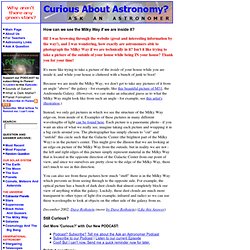
I was browsing through the website (great and interesting information by the way!) , and I was wondering, how exactly are astronomers able to photograph the Milky Way if we are technically in it? Isn't it like trying to take a picture of the outside of your house while being IN your house? Thank you for your time! It's more like trying to take a picture of the inside of your house while you are inside it, and while your house is cluttered with a bunch of junk to boot! Because we are inside the Milky Way, we don't get to take any pictures of it from an angle "above" the galaxy - for example, like this beautiful picture of M31, the Andromeda Galaxy. The Size Of Our World - StumbleUpon. Our Solar System: Facts, Discovery, Exploration &Formation. The solar system is made up of the sun and everything that orbits around it, including planets, moons, asteroids, comets and meteoroids.
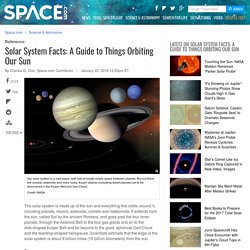
It extends from the sun, called Sol by the ancient Romans, and goes past the four inner planets, through the Asteroid Belt to the four gas giants and on to the disk-shaped Kuiper Belt and far beyond to the giant, spherical Oort Cloud and the teardrop-shaped heliopause. Scientists estimate that the edge of the solar system is about 9 billion miles (15 billion kilometers) from the sun.
For millennia, astronomers have followed points of light that seemed to move among the stars. The ancient Greeks named these planets, meaning "wanderers. " Mercury, Venus, Mars, Jupiter and Saturn were known in antiquity, and the invention of the telescope added the Asteroid Belt, Uranus, Neptune, Pluto and many of these worlds' moons. Can Life Thrive Around a Red Dwarf Star? Roughly three quarters of the stars in the galaxy are red dwarfs, but planet searches have typically passed over these tiny faint stars because they were thought to be unfriendly to potential life forms.
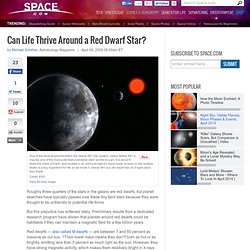
But this prejudice has softened lately. Preliminary results from a dedicated research program have shown that planets around red dwarfs could be habitable if they can maintain a magnetic field for a few billion years. Red dwarfs — also called M dwarfs — are between 7 and 60 percent as massive as our sun. ? Their lower mass means they don? T burn as hot or as brightly, emitting less than 5 percent as much light as the sun. To understand the environment around these common stars, the "Living with a Red Dwarf" program was started three years ago.
"This is the information that you would want to know to model the suitability for life on a nearby planet," says Ed Guinan of Villanova University, a scientist working with the program. Death lock Still, life might not be a picnic around a red dwarf. The Solar System Looks Way Better Than It Used To. Rocket launch blows away the sky.
Lost treasures: The missing Mars Polar Lander - 07 February 2012 - New Scientist - StumbleUpon. Planetarium - Interactive star map and virtual sky - StumbleUpon. StumbleUpon. Astronomy Picture of the Day Archive - StumbleUpon. - StumbleUpon. - StumbleUpon. Space junk facts. Skip to Content Home » Space junk facts Space junk facts Bookmark/Search this post with: Copyright © 2014 .
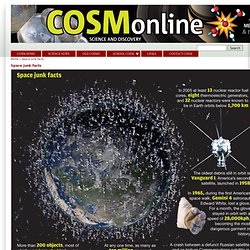
Copyright 2010 Ben Gilliland Theme by Dr. ASTR 1230, Whittle [Fall 2009]. Lecture Notes. Lunar Eclipses for Beginners. 2004 Lunar Eclipse SequenceThe total lunar eclipse of 2004 Oct 28 was widely visible from the USA.This sequence of images captures the eclipse from start (right) to finish (left).

(click to see more images) (c) Copyright 2007 by Fred Espenak Introduction. Astronomy For Beginners...Astronomy Basics...Amazing Astronomy Facts - StumbleUpon. Scientists Find Evidence for "Great Lake" on Europa and Potential New Habitat for Life &124; JSG News. Europa's "Great Lake.
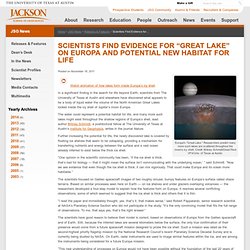
" Researchers predict many more such lakes are scattered throughout the moon's icy shell. Credit: Britney Schmidt/Dead Pixel VFX/Univ. of Texas at Austin. Watch animation of how lakes form inside Europa’s icy shell. The Lagoon Nebula in Mapped Color. The Eagle Nebula in Mapped Color. Mysteries of Deep Space - History of the Universe Timeline - StumbleUpon. Earth As Seen from Mars - Marvin the Martians front lawn. Marvin the Martian's front lawn - Franny Wentzel - Saturday, April 24th, 2010 : goo [previous] :: [next] This is the first image ever taken of Earth from the surface of a planet beyond the Moon. It was taken by the Mars Exploration Rover Spirit one hour before sunrise on the 63rd Martian day, or sol, of its mission.
(March 8, 2004) The image is a mosaic of images taken by the rover's navigation camera showing a broad view of the sky, and an image taken by the rover's panoramic camera of Earth. Credit: NASA/JPL/Cornell/Texas A&M.